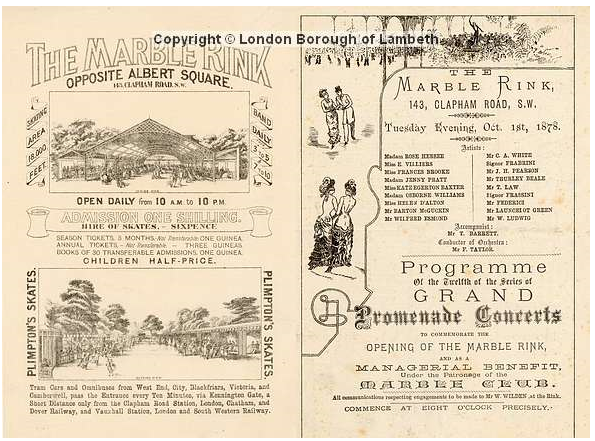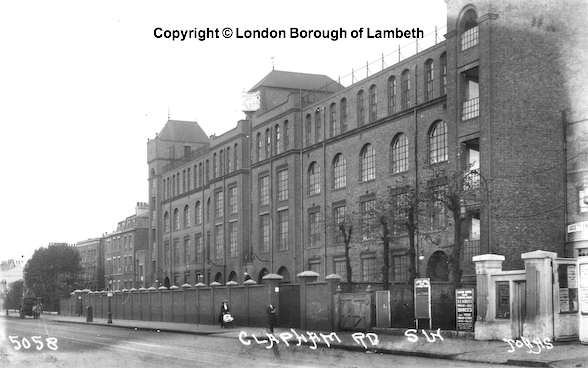And in the photograph there was a clock. Well, an opportunity like that cannot be resisted.
The Printworks was built in 1903 as, well, a print works for Caustons, a company who made labels and other such material for other companies.
Further information about the building can be found on at www.ovalhistory.co.uk. The following information is taken from that site:
139 Clapham Road is now home to The Printworks, a new development which converted this grand old factory into modern flats and office space. However before anything stood on this plot of land it was occupied by, of all things, an 1800 foot roller skating rink and athletics space called The Marble Rink which opened in 1878.

The space took on a multi-purpose entertainment venue role shortly after opening. On 20-25 June 1881 a 6 day non stop roller skating race took place, that must have took quite some stamina.

Handbill for the Marble Rink. Copyright © The British Library Board
The Marble Rink fell out of popularity as tastes changed and the site acquired by Sir Joseph Causton where in 1903 he built a huge printworks which still stands today.
Joseph Causton was a politician, becoming a Councillor for Billingsgate, East London in 1868 and Sheriff for London and Middlesex in 1868. The pinnacle of his career came when Queen Victoria opened Blackfriars Bridge and Holborn Viaduct in 1869 and he was knighted at Windsor Castle to mark the event. The company name then became Sir Joseph Causton and Sons Limited. Sir Joseph died just two years later, but his sons, Joseph, Richard, and James, continued as partners of the firm.

The Printworks in 1914
Causton’s were one of the UK’s biggest printing firms and made labels for household brands including Marmite and Guiness. Then in 1937 they moved away to Hampshire and the building was acquired by Freeman’s Catalogue Ltd. Freemans had started trading in 1905, making it one of the oldest catalogues in the UK. It began in a two room terraced house in Lavender Sweep, London by Arthur and Stanley Rampton, William Jones and Henry Freeman. It was during the mail order boom time in the 1930s that it moved to 139 Clapham Road which they renamed Lavender House. Freeman’s was by then the largest mail order business in Great Britain; larger than all its competitors put together. Some of its 30,000 agents managed to buy cars and houses with their commission money. Freeman’s added a substantial number of new buildings around Causton’s original centre structure, letting out parts of the site to other companies such as a donut factory in a little art-deco building once attached to left hand side of the frontage.

The Doughnut Corporation of America (DCA) established a subsidiary in the UK under the name of the British Doughnut Company. It made American type ring doughnuts and distributed them by tricycle to catering outlets in the area around their premises in Clapham Road. They were known as Downyflake Doughnuts. It also imported doughnut making machines from the US which were sold to bakers and caterers together with doughnut mixes which were blended in the Clapham Road factory.
During World War 2 a tragedy struck and the building took a direct bomb hit killing 23 young women, you can read more about this incident in the Bombing and War section of my website here.
Following the business’s relocation to West Yorkshire, the Freemans building and surrounding site has been redeveloped by Galliard Homes as housing and business units. Two new streets that run either side of the original building have been created: Lett Road and Printer Road.








No comments:
Post a Comment